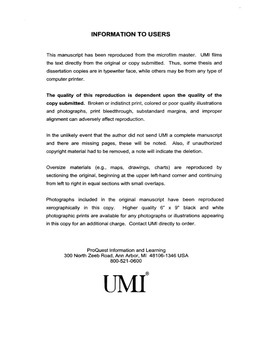| dc.contributor.advisor | Tan, David, | en_US |
| dc.contributor.author | Cobb, Christine Maria Soh Guek Tin. | en_US |
| dc.date.accessioned | 2013-08-16T12:18:14Z | |
| dc.date.available | 2013-08-16T12:18:14Z | |
| dc.date.issued | 2001 | en_US |
| dc.identifier.uri | https://hdl.handle.net/11244/308 | |
| dc.description.abstract | The partial correlation findings revealed that all the six brand identity attributes had a positive correlation with students' ratings of their academic and social integration. Amongst the student characteristics, gender, students' financial aid status, housing arrangements (living on or off campus), current cumulative GPA, family's annual income and parents' educational attainment were found to be correlated with one or more of the six brand identity attributes. Of the six brand identity attributes, an institution's emphasis on the quality of its academic and non-academic programs had the highest ranking based on students' perception. Amongst the top five positive reasons for students intent-to-persist, institutional commitment and quality of programs were perceived to be the most important. Personal reason (distance from home) and difficulty with academic integration were cited as the top two reasons for students' non-persistence. | en_US |
| dc.description.abstract | In this study, brand identity was defined as "what a college wants to be known for." Colleges could be perceived as providing a "product" (blending academic, social, and credentialing components) to their students/"customers." The assumption made in this study was that students' positive perception of their colleges' brand identity through their freshmen year might increase their satisfaction, enhance their loyalty to their college, and thereby increase their persistence. | en_US |
| dc.description.abstract | The six brand identity attributes from business literature that were identified to be most applicable to higher education were: (a) vision of the institution's brand identity, (b) brand-customer relationship, (c) total employee commitment, (d) quality of programs, (e) commitment of financial resources, and (f) pricing. Tinto's (1996) findings on student persistence indicated that interaction among students' goal and institutional commitment could affect their academic and social integration, which in turn could impact their persistence. | en_US |
| dc.description.abstract | The purpose of this research was to examine students' perception of the six brand identity attributes and the relationship of these brand identity attributes to factors affecting their intent-to-persist. Twenty-first century demographic and financial trends will compel colleges to improve their retention percentages. A crucial tool that could be borrowed by colleges from the business world to accomplish this task is "brand identity, " often expressed in mission statements. | en_US |
| dc.format.extent | xiv, 197 leaves : | en_US |
| dc.subject | Education, Higher Oklahoma Public opinion. | en_US |
| dc.subject | Education, Administration. | en_US |
| dc.subject | College dropouts United States Prevention. | en_US |
| dc.subject | Business Administration, Marketing. | en_US |
| dc.subject | Education, Educational Psychology. | en_US |
| dc.subject | University of Oklahoma Students Attitudes. | en_US |
| dc.subject | University of Oklahoma Public opinion. | en_US |
| dc.subject | Education, Higher. | en_US |
| dc.title | The concept of brand identity in relation to students' intent-to-persist. | en_US |
| dc.type | Thesis | en_US |
| dc.thesis.degree | Ph.D. | en_US |
| dc.thesis.degreeDiscipline | Department of Educational Leadership and Policy Studies | en_US |
| dc.note | Chair: David Tan. | en_US |
| dc.note | Source: Dissertation Abstracts International, Volume: 62-02, Section: A, page: 0481. | en_US |
| ou.identifier | (UMI)AAI3006667 | en_US |
| ou.group | Jeannine Rainbolt College of Education::Department of Educational Leadership and Policy Studies | |
